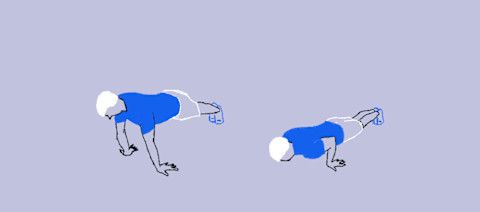
Whether you love them or you hate them, you cannot deny that pushups are an effective upper-body and core exercise. You probably know that you can modify pushups to make them a bit easier (think knees on the ground or hands on an elevated surface). Or you can make them even more challenging by elevating your feet, for example. But were you aware you can do different types of pushups to target specific areas of your body? A few minor changes can totally shift which muscles are emphasized during the move.
Ready to put your strength to the test? Give these pushup variations a try during your next workout:
Wide Pushup

How to: Begin by getting into a high plank position, with your feet together, neck in a neutral position, and body in line. Place your hands on the ground wider than shoulder-width apart with your fingertips facing forward. This is your starting position. Slowly lower your chest toward the ground by bending at the elbows while breathing in. Your elbows should face slightly to the side and behind you. Pause, then push using your chest to return to the starting position while breathing out. Be sure to keep your core tight and engaged throughout the movement. That's one rep.
Note: If this exercise is too difficult, place your hands on an elevated surface (like a table or stool) to remove some of the resistance.
Benefits: This variation puts more stress and emphasis on the chest.
Reverse Hands Pushup

How to: Begin by getting into a high plank position with your feet together, neck in a neutral position, and body in line. Place your hands on the ground approximately shoulder-width apart with your fingertips facing behind you. This is your starting position. Slowly lower your chest toward the ground by bending at the elbows while breathing in. Lower until your biceps are nearly parallel to the ground. Be sure to keep your elbows tucked in toward your body and facing your feet while lowering. Pause, then push up using your biceps to return to the starting position while breathing out. That's one rep.
Note: If this exercise is too difficult, position yourself between two tables or chairs. Place one hand on each surface to perform your repetitions.
Benefit: This variation puts more stress and emphasis on the biceps.
Diamond Pushup

How to: Begin by getting into a high plank position with your feet together, neck in a neutral position, and body in line. Place your hands on the ground under your chest with your thumbs and index fingers connected to form a triangle. This is your starting position. Slowly lower your chest toward the ground by bending at the elbows while breathing in. Be sure not to flare your elbows or allow your hips to sag as you lower down. Pause, then push through your triceps to return to the starting position while breathing out.
Note: If this exercise is too difficult, begin by mastering a narrow pushup. The narrow hand placement also uses the triceps and will build your strength until you're ready to master the triangle hand position.
Benefit: This variation puts more stress and emphasis on the triceps.
Pike Pushup

How to: Begin by getting into a high plank position with your feet together, neck in a neutral position, and body in line. Place your hands on the ground, shoulder-width apart with your fingertips facing forward. Walk your feet in toward your hands, raising your hips into the air. Your arms and legs should form an inverted "V" shape. This is your starting position. Slowly lower your upper body toward the ground by bending at the elbows while breathing in. Be sure to keep your elbows tucked and torso straight. Pause, then push using your shoulders to return to the starting position while breathing out. That's one rep.
Note: If this exercise is too easy, you can elevate your feet onto a chair or table to perform your repetitions.
Benefit: This variation puts more stress and emphasis on the shoulders.
Archers Pushup

How to: Begin by getting into a high plank position with your feet together, neck in a neutral position, and body in line. Place your hands on the ground wider than shoulder-width apart with your fingertips facing forward. This is your starting position. Slowly lower your chest toward the floor on your left side by bending your elbow while breathing in. This is the working arm. The right arm will be straight and extended. Pause, then push up using your left side to return to the starting position while breathing out. That's one rep.
Note: If this exercise is too difficult, bend your extended arm as needed. This will allow you to adjust the amount of assistance and remove some of the resistance from the working side.
Benefits: This variation puts more stress and an increased load on the working arm.
Superman Pushup

How to: Begin by getting into a high plank position with your feet together, neck in a neutral position, and body in line. Place your hands on the ground shoulder-width apart, and then place your hands about a foot in front of your head. This is your starting position. Slowly lower your chest toward the ground while breathing in. Be sure to keep your core engaged and body in a straight line. Do not let your hips sag. Pause, then push up using your back to return to the starting position while breathing out. That's one rep.
Note: If this exercise is too difficult, perform your repetitions with your knees bent on the ground.
Benefits: This variation puts more stress and emphasis on the back.
